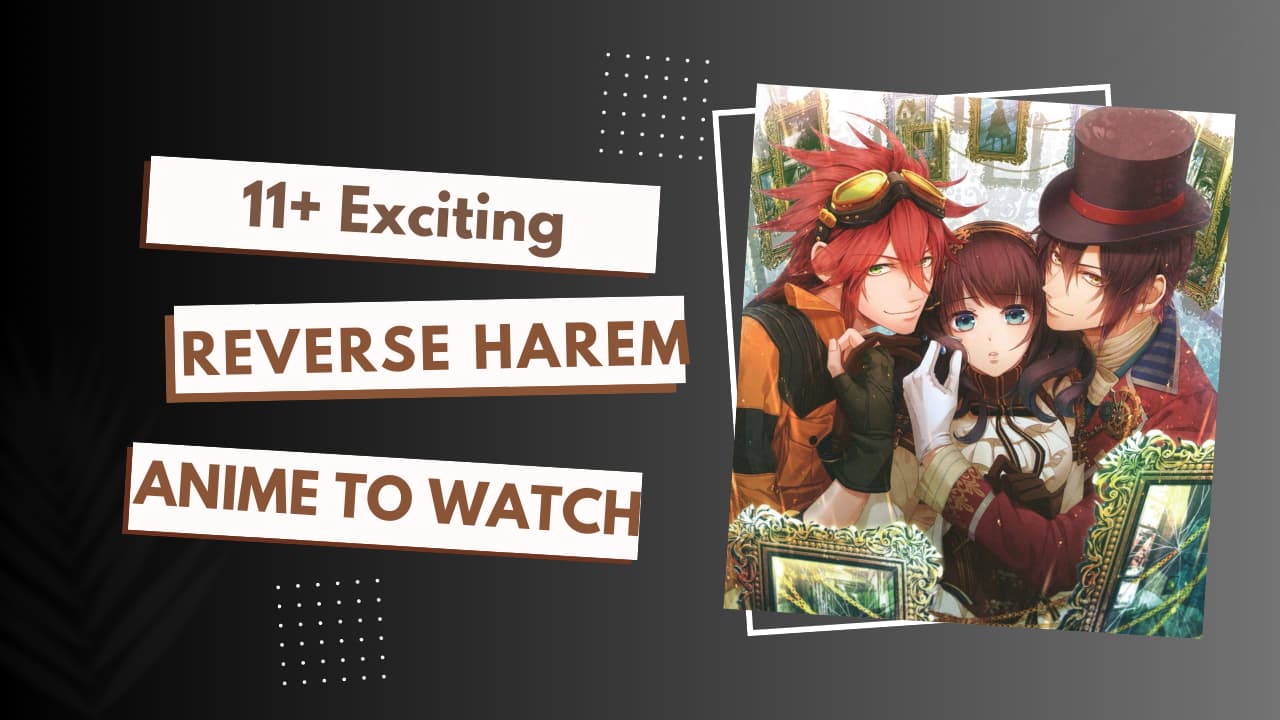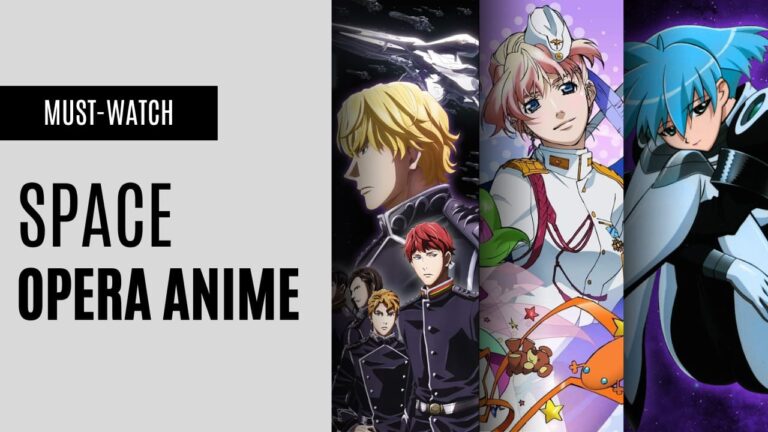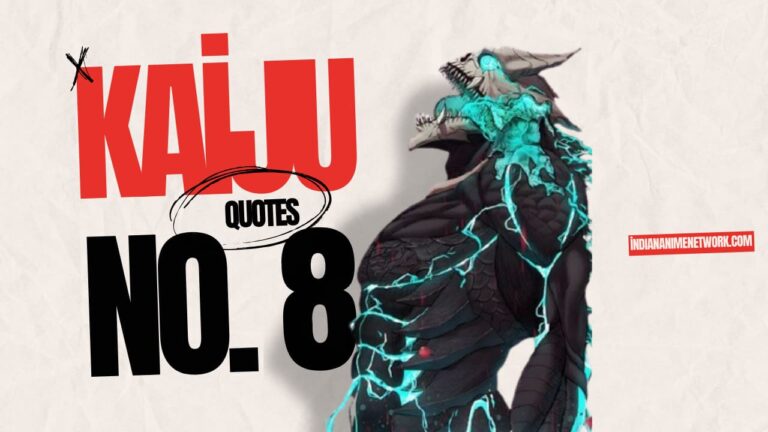11+ Exciting Reverse Harem Anime to Watch in 2025
Reverse harem anime is a subgenre of harem anime characterized by a single female protagonist who is surrounded by multiple male characters who are romantically interested in her.
Unlike traditional harem anime, where one male character is surrounded by several female love interests, reverse harem shifts this dynamic to focus on the female perspective.
The central character is usually a strong, relatable female who often has a unique background or personality traits that make her appealing to the male characters.
The storyline typically involves a diverse group of male characters, each with distinct personalities, backgrounds, and reasons for being attracted to the female lead.
The interactions often center on romantic tension, with various subplots involving the male characters vying for the attention or affection of the female protagonist.
These series often explore the relationships and personal growth of both the female lead and her male counterparts, allowing for emotional depth and complexity.
Many reverse harem anime incorporate fantasy elements, such as supernatural powers or unique settings, while others focus on everyday life scenarios that lead to romantic developments.
Fruits Basket (2001 & 2019):
Fruits Basket introduces viewers to a reverse harem storyline that carries a deep sense of heart, healing, and humanity.
The story follows Tohru Honda, a high school girl who stumbles upon the Sohma family’s secret—a curse that transforms family members into animals of the Chinese zodiac when hugged by the opposite sex.
Tohru’s character stands as a beacon of kindness and optimism, despite her personal tragedies, including the death of her mother and her homelessness.
Her journey is not just about discovering the hidden curse but also about healing the broken hearts of those around her, embodying themes of acceptance and compassion.
The world of Fruits Basket is an emotional tapestry, with the curse adding layers of intrigue to the Sohma family’s dynamics.
This supernatural element is interwoven with the realistic portrayal of human emotions, which deepens the narrative, making it resonate with audiences on a personal level.
The origins of this world building lie in the zodiac myth, but what sets this series apart is the way it grounds the curse in real human pain and family trauma.
Tohru becomes a catalyst for change, “In a world that feels so broken, sometimes all you need is a heart that listens.”
Tohru’s interactions with unique characters like Kyo Sohma, the hotheaded cat of the zodiac, and Yuki Sohma, the charming yet distant rat, reflect the inner battles each character faces.
Their relationships with Tohru highlight her ability to see beyond their flaws and reach their vulnerabilities.
These moments are underscored by the idea that healing comes not from fixing others, but from simply being there to listen and understand.
Fruits Basket as a reverse harem is more than a romantic drama; it’s a meditation on the complexities of family, love, and the enduring strength of the human spirit.
Its legacy as a beloved classic lies in its ability to touch hearts through a narrative of empathy, showing that “In accepting others, we begin to heal ourselves.”
Ouran High School Host Club(2006):
Ouran High School Host Club is a delightful reverse harem anime that flips traditional gender roles and expectations while delivering a blend of humor, romance, and social commentary.
At its heart is Haruhi Fujioka, a bright and independent scholarship student who stumbles into the elite world of the Ouran Academy.
Mistaken for a boy after accidentally breaking a valuable vase, Haruhi is roped into becoming a member of the school’s Host Club to repay her debt.
Her unassuming and pragmatic demeanor contrasts sharply with the lavish and often absurd antics of the wealthy students around her.
The world of *Ouran* is a carefully crafted exaggeration of high-class society, where every detail in the Host Club—from the extravagant tea parties to the themed costumes—serves as a parody of aristocratic life.
Haruhi’s journey through this world reveals not just her ability to navigate these foreign social waters but also the often superficial nature of wealth and privilege.
The fact that she is mistaken for a boy throughout much of the series serves as a clever device to explore themes of gender fluidity and identity without losing its comedic charm.
“What matters is not what you are, but who you are,” is a sentiment echoed in the series, as Haruhi’s down-to-earth personality gradually breaks through the facades of her fellow club members.
These characters—Tamaki Suoh, the flamboyant leader, and the mysterious Kyoya Ootori, to name a few—are all drawn to Haruhi not just for her unconventionality but for the way she forces them to confront their own insecurities and superficialities.
Through its humor, Ouran High School Host Club ultimately delivers a refreshing take on the reverse harem genre, poking fun at gender norms while offering a touching and often hilarious journey of self-discovery and acceptance.
The series serves as a reminder that “the true wealth lies not in material possessions, but in understanding and accepting who we truly are.”
The Wallflower (The Seven Metamorphoses Of Yamato Nadeshiko)(2006):
The Wallflower, also known as The Seven Metamorphoses of Yamato Nadeshiko, is a unique entry into the reverse harem genre, blending gothic comedy with heartwarming moments of transformation.
The series revolves around Sunako Nakahara, a reclusive, horror-obsessed girl who rejects societal beauty standards after being rejected by her crush.
Her extreme aversion to anything beautiful, especially the four handsome boys she lives with, sets the stage for both humor and emotional depth.
The world building centers around an extravagant mansion owned by Sunako’s aunt, who tasks the four boys—Kyohei, Yukinojo, Takenaga, and Ranmaru—with transforming Sunako into a “perfect lady.”
In exchange for their success, they get free rent. This setting creates a quirky, isolated bubble where the characters’ eccentricities shine.
It is in this mansion, amidst exaggerated gothic elements and over-the-top reactions, that the narrative explores themes of self-worth, beauty, and acceptance.
“I don’t need beauty, for I find comfort in the darkness,” Sunako declares, embodying a rejection of societal norms.
Sunako’s character stands out as a refreshing inversion of typical harem tropes. Instead of a love-struck heroine, she is a dark, self-loathing individual who delights in horror films, anatomical models, and isolation.
Her journey from reclusive to self-acceptance drives the narrative forward, though the anime never forces her to fully conform to conventional beauty standards, maintaining her individuality.
The series subverts expectations, using its reverse harem setup to tell a deeper story about personal growth and inner beauty. Sunako’s relationship with Kyohei, though full of clashes, forms a core emotional anchor.
The humor and heart of The Wallflower ultimately lie in its message—that self-acceptance is more important than societal ideals. “In a world obsessed with beauty, finding solace in one’s uniqueness is the greatest metamorphosis of all.”
Kamisama Kiss(2012):
Kamisama Kiss is a heartwarming reverse harem anime that centers around Nanami Momozono, a high school girl who unexpectedly becomes the new land god of a shrine.
The story begins with her abandonment due to her father’s debt, only to be led into the spiritual world by the former god, Mikage.
Nanami’s growth as a deity is both endearing and relatable, as she navigates her new responsibilities while maintaining her grounded human qualities.
Her character is defined by her optimism, determination, and compassion, making her stand out in a world full of spirits, yokai, and supernatural creatures.
The world-building in Kamisama Kiss blends traditional Japanese folklore with modern-day settings, creating a whimsical yet profound backdrop for Nanami’s journey.
The shrine, where much of the action unfolds, becomes a microcosm of the spiritual realm, brimming with ancient deities and mythological creatures.
This intersection of the human and divine worlds allows the anime to explore deeper themes of love, duty, and the balance between the two realms.
“Even gods have flaws, but it’s in their humanity that they find strength,” a sentiment that beautifully encapsulates the narrative’s underlying message.
As Nanami meets various characters, particularly the mysterious and powerful fox familiar, Tomoe, her relationships become central to the story.
Tomoe’s gradual transformation from a cold, distant figure to someone fiercely loyal and protective of Nanami provides much of the series’ emotional weight.
His complex past and internal struggles with love and vulnerability add depth to their bond, elevating the series beyond simple romance.
Kamisama Kiss artfully merges traditional mythological elements with modern romance, making it a delightful experience for fans of reverse harem.
The balance of lighthearted humor and emotional depth allows the anime to shine, leaving viewers with the idea that love and strength can be found in the most unexpected places.
Amnesia(2013):
Amnesia offers a compelling blend of mystery, romance, and the supernatural, weaving together a reverse harem narrative centered around a nameless heroine.
The series starts with the protagonist waking up with no memory of her life, surrounded by men who seem to know her intimately.
This premise sets the stage for a journey that is not only about recovering her lost memories but also unraveling the deeper complexities of her existence.
The world-building is steeped in supernatural elements, anchored by the concept of parallel worlds. As the heroine interacts with the five male leads, each represents a different reality or “world” that she has to navigate.
This setup introduces a captivating dynamic, where the heroine’s choices and relationships subtly shift depending on which timeline she inhabits.
The structure lends an intriguing, non-linear flow to the story, with clues gradually piecing together the fragmented past.
The visual presentation of these worlds reflects this complexity, with each being richly detailed yet distinctive, representing the emotional tones of her relationships.
“To lose yourself is one thing, but to forget who you loved is a tragedy even deeper.”
This line underscores the emotional core of *Amnesia*, where the heroine’s journey becomes an exploration of self-identity and affection amidst an environment rife with enigma
As for the unique male characters, Shin, Ikki, and Kent each represent differing facets of her emotional connections.
Their relationships with her are built through an atmosphere of uncertainty, heightening the romantic tension.
However, the heroine herself, passive yet emotionally burdened, serves as a vessel for viewers to question the fluidity of memory and love.
In the grander scale of reverse harem anime, *Amnesia* brings forth a darker, more introspective take on love, memory, and identity.
Its exploration of fractured realities, coupled with a subtle emotional depth, makes it a standout in the genre, inviting viewers to question the nature of relationships when memories fade but feelings remain.
Yona of the Dawn(2014):
Yona of the Dawn stands out as a compelling reverse harem anime, centered around Princess Yona, who transforms from a sheltered, naive royal into a formidable and determined leader.
The story begins with Yona’s life of privilege in the kingdom of Kouka being shattered when her cousin and first love, Su-won, betrays her and murders her father, the king.
Forced to flee her palace, Yona embarks on a journey to reclaim her kingdom, gather the Four Dragon Warriors, and confront the dark reality of her world.
The world-building in *Yona of the Dawn* is inspired by historical Korea, with richly drawn landscapes, ancient legends, and a political backdrop rife with tension.
The anime weaves a narrative about loyalty, self-discovery, and the burden of leadership.
As Yona travels through her broken kingdom, she is exposed to the poverty, conflict, and inequality her father’s rule allowed, challenging her to grow into a compassionate, fierce ruler.
Yona herself is the heart of the series. What begins as a princess reliant on her protector, Hak, evolves into a warrior who learns to wield a bow and fight for the people she cares about.
Her bond with Hak, who harbors deep unspoken feelings for her, forms the emotional core of the series.
Along the way, the Four Dragon Warriors—each with unique powers and personalities—begin to gather around her, creating the reverse harem dynamic.
However, this dynamic serves the story’s greater purpose of Yona’s quest, and it avoids many typical clichés.
“There are no shortcuts to achieving something meaningful,” Yona states, capturing her growth and the show’s underlying message of perseverance.
With strong animation and an engaging, emotional journey, Yona of the Dawn stands out as a reverse harem anime where romance never overshadows the protagonist’s path to becoming a true leader.
The story’s careful balance of action, politics, and emotional depth continues to resonate in anime history.
Code: Realize – Guardian Of Rebirth (2017):
Code: Realize – Guardian of Rebirth is a quintessential reverse harem anime, centering around the mysterious and isolated female protagonist, Cardia Beckford.
Suffering from a rare condition where her body produces a deadly poison, Cardia’s touch is lethal, rendering her incapable of human contact.
This curse forms the emotional core of the anime as she embarks on a journey to uncover the secrets of her condition and find a way to live normally again.
The world-building of Code: Realize is rooted in a steampunk version of Victorian England, complete with iconic literary figures such as Arsène Lupin, who leads Cardia through her quest.
The narrative beautifully intertwines historical and fantastical elements, blending recognizable names and places with the whimsical mechanics of a clockwork world.
The characters Cardia meets, all drawn to her by the allure of her mystery, include figures like Victor Frankenstein and Impey Barbicane, each bringing their own personal motivations to her journey.
“The poison in my body may have taken everything from me, but it is not the only thing that defines me,” Cardia reflects as she slowly grows from a helpless bystander in her own life to a key player in the story.
This sentiment marks her development into a more empowered character, transforming from a passive victim of her curse to someone who actively seeks out her own destiny.
The steampunk aesthetic is a highlight, enhancing the adventurous tone of the series, while the beautifully rendered landscapes and ornate costumes underscore the grandeur of the Victorian era.
The reverse harem aspect feels organic, as each love interest has a meaningful role in both the overarching mystery and Cardia’s personal growth.
In the end, Code: Realize offers more than just romance; it’s a journey of self-discovery wrapped in a charming steampunk world, leaving a lasting impact on the reverse harem genre.
Phantom Of The Twilight (2018):
Phantom in the Twilight emerges as a reverse harem narrative imbued with a Gothic undertone, set against the backdrop of a London where supernatural entities lurk in the shadows of reality.
The series unravels the journey of Baileu Ton, a steadfast protagonist, distinguished not by fragility but by her unwavering resolve to confront the unknown.
With an intrinsic strength rooted in her ancestral lineage, Ton is depicted as a rarity in reverse harem—a heroine whose courage and agency guide the plot rather than being swayed by the allure of her supernatural protectors.
The story’s world-building finds its origin in the “Shadow World,” a plane intersecting reality and fantasy, where mystical creatures known as “Umbra” exist, shunned by humanity yet drawn into its folds.
The blend of Victorian aesthetics with arcane magic introduces an alluring dichotomy, encapsulated in the setting of Café Forbidden.
This enigmatic place serves not only as a haven for these otherworldly beings but also as the crux where secrets and destinies intertwine.
“Life is not a place of safety or comfort; it is a battlefield where every choice etches the soul deeper into the darkness or carves it towards the light.”
This ethos courses through Ton’s evolution as she grapples with loss, defies destiny, and navigates the murky waters of allegiance.
Although it lacks the genre’s typical romantic pull, Phantom of the Twilight retains its intrigue through its unpredictable narrative and multifaceted characters like Vlad Garfunkel, a vampire with a complex history, and Luke Bowen, the loyal guardian whose presence reverberates with sincerity.
This anime remains a delicate dance between mystery and emotional resonance, wrapping itself in a tale of resilience where Ton’s courage illuminates even the deepest shadows.
My Next Life as a Villainess: All Routes Lead to Doom! ( 2020):
My Next Life as a Villainess: All Routes Lead to Doom! breathes new life into the reverse harem genre by blending lighthearted humor with clever narrative twists; one look at the trailer, and you’ll see why it’s a must-watch for you reverse harem freaks!
The anime follows Katarina Claes, a highborn noble who regains memories of her past life, only to realize she’s reincarnated as the antagonist in an otome game called Fortune Lover.
Aware that every possible storyline ends with her exile or death, Katarina takes it upon herself to outmaneuver her fate.
The world of My Next Life as a Villainess is set within the opulent halls of a magical aristocracy, combining elements of romantic intrigue and whimsical sorcery.
The series taps into the popular “isekai” trope but subverts expectations by positioning the main character not as the destined heroine but as the villain herself.
This inversion infuses a refreshing unpredictability into the typical reverse harem setup, where Katarina inadvertently wins over the affections of everyone around her while obsessively trying to avoid her own doom.
What makes her journey compelling is Katarina’s sheer obliviousness. Despite her strategic mind and relentless efforts, she remains hilariously unaware of the romantic tension she stirs.
“Sometimes the greatest power is not in magic or nobility, but in the simple kindness that softens the harshest of hearts.”
It’s through these unintended acts of compassion that she charms her would-be enemies, transforming rivals into allies and romantic suitors.
By the end, the anime’s charm lies not in whether Katarina evades her fate but in how she redefines her role entirely.
Rather than succumbing to the constraints of her villainous identity, she becomes a force of change, rewriting each route of the game through sheer willpower and kindness.
Katarina Claes, instead of embodying villainy, reshapes her fate, proving that destiny can be rewritten by those daring enough to defy it.
The Saint’s Magic Power Is Omnipotent (2021):
The Saint’s Magic Power is Omnipotent introduces Sei Takanashi, a modern-day office worker unexpectedly transported to the magical kingdom of Salutania.
Unlike many reverse harem leads, Sei’s character radiates a sophisticated grace. Despite the premise’s fantastical nature, her grounded demeanor adds a refreshing contrast.
Subtly complex, she finds herself caught between admirers not solely for her beauty but for the enchanting magic she wields, a power that surpasses even seasoned mages. Her aura reflects a quiet strength, effortlessly drawing others toward her.
Salutania’s world-building roots lie in the age-old trope of summoning saints to combat emerging demonic threats. The ceremony, however, misfires, pulling two women into this world—Sei and the seemingly more “heroic” Aira.
As an “accidental” saint, Sei’s role appears secondary, which is a clever twist, transforming her journey into one of self-discovery rather than grandeur.
The complexity of Salutania’s society is explored through Sei’s interactions, blending court intrigue, herbalism, and magic.
Her journey is imbued with subtle delights, such as learning potion-making and cultivating rare herbs.
As her magical talents bloom, characters like the enigmatic Albert Hawke and the scholarly Jude offer more than just romantic subplots.
“For every elixir she brewed and spell she cast, she stitched herself into the fabric of a world that tried to reject her.” Instead of conforming, Sei carves a niche, subtly altering Salutania’s fate.
As a reverse harem, the anime subverts genre norms by making romance a gradual unfolding rather than immediate infatuation.
Sei’s gentle yet undeniable impact on her suitors isn’t driven by charisma alone but by the “quiet power” she exudes—a reminder that sometimes, true omnipotence is more about presence than force.
Trapped in a Dating Sim: The World of Otome Games is Tough for Mobs (2022):
“Trapped in a Dating Sim: The World of Otome Games is Tough for Mobs” emerges as a fresh take on the reverse harem genre, blending satire and social critique with a surprisingly engaging narrative.
Its world-building is rooted in the concept of a hyper-capitalistic fantasy kingdom inspired by typical otome games, where social standing is everything, and power dynamics dictate relationships.
Leon Fou Bartfort, the atypical male protagonist, is reincarnated into this hierarchy as a lowly “mob”—a background character meant to be inconsequential.
Yet, he subverts expectations by using his knowledge of the game to manipulate outcomes in his favor.
The female lead, Olivia, stands out due to her unconventional position in this world. Rather than a powerful noble or ambitious heroine, Olivia begins as a scholarship student—a gentle, seemingly timid presence.
However, she conceals inner strength and an unyielding moral compass that compels Leon to stand by her. As Leon puts it, “She’s the only one in this rotten world who sees value in people beyond their status.
That’s why I’ll never let anyone trample on her.” Her role subtly redefines the genre’s conventions, making her more than just the typical love interest.
The story thrives on its unpredictability and the skewering of standard tropes. The greatest irony, however, lies in Leon’s position; while he’s self-aware of his ‘mob’ status, his defiance and bold tactics constantly draw the attention of powerful characters, including the egotistical Prince Julius, creating a dynamic filled with tension and humor.
Ultimately, the series comments on the absurdity of rigid social norms. Though Leon starts as a self-serving character, his actions inadvertently uplift Olivia and challenge the status quo, illustrating that in a world built on hierarchy, even a “mob” can be a disruptor.







